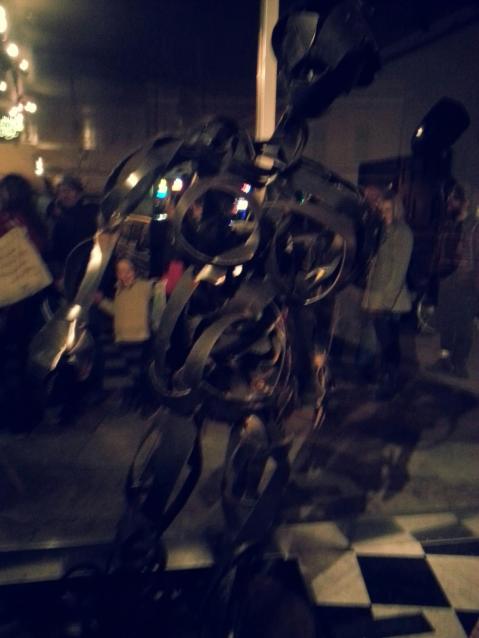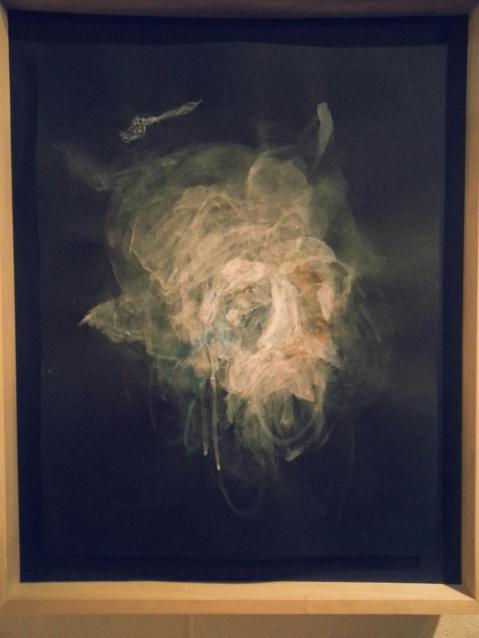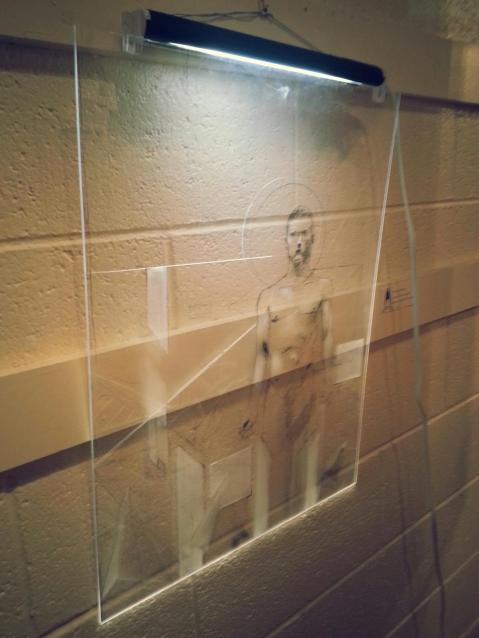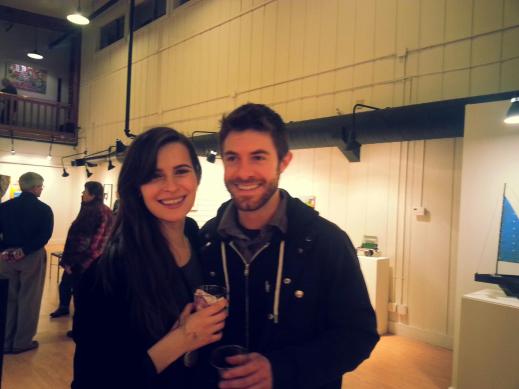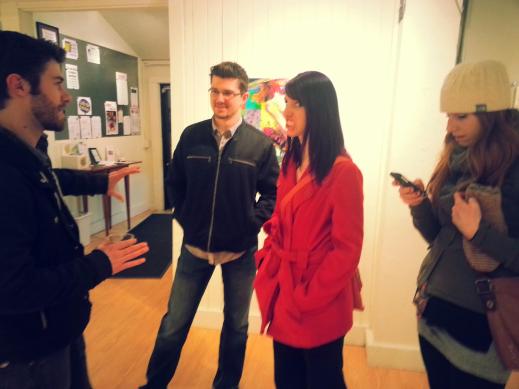March 2013 First Friday
Start the first Friday of your month off right with first Friday art walk in old town Fort Collins. There are a variety of options for where to go and what to do and some even involve free beer or pizza by the slice. Get the map and participating locations at the following link: http://downtownfortcollins.com/events/first-friday-featuring-gallery-walk
If you can’t bike or walk you might want to get downtown early on first Friday’s because parking can be frustrating, but after circling and taking the back roads you always find something. My friends and I found parking near the Wright Life and then started our night.
We were walking over to Harper Point Photography when we came across a room on Walnut with designer skateboards and prints on the walls. We had to check it out. This place was packed and beer and pizza were being sold to a line in the back corner. The non-profit organization putting it on was Launch and their boards looked amazing. A style for every person could be found. Check out their art and organization: http://launchskate.wordpress.com/about/ We saw designs from a Mr. Fox lookalike to a Wookiee to boards with attachments coming off of them.
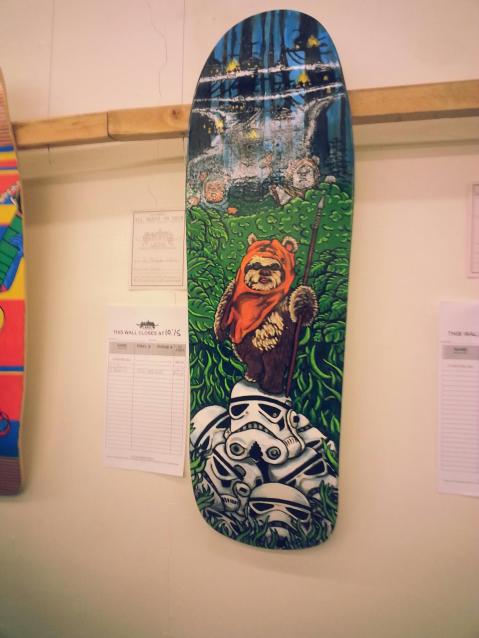
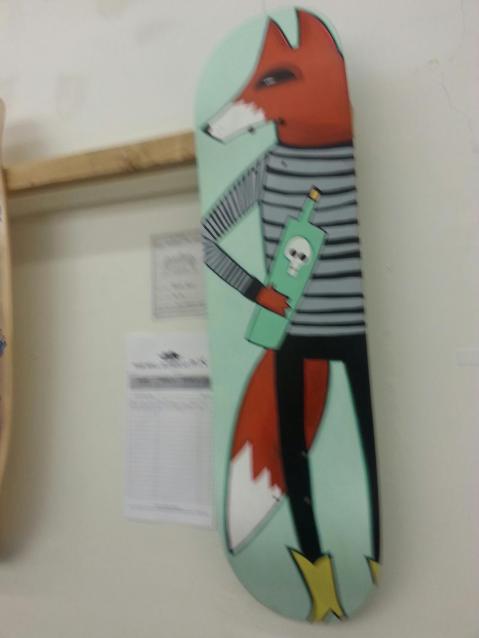
These people know what they’re doing and it’s all for a good cause. Plus, it being FoCo you run into all kinds of cool people and friends. I wish we could have stayed longer.
We then made it over to Harper Point http://www.harperpoint.com/
and said Hi to Kira and Nate the owners who have a great concept of color and design. Their namesake is from their dog Harper, with their kid Jude they’re the sweetest little family. They do everything from weddings and fashion to head shots and high school senior photo shoots. At their little studio with the red garage door off Pine St. their was a live band playing and a table of free food. Unfortunately when we arrivedthe band had just stopped playing but the photographs and people crammed in their made for a good time.
Next on the list was the Opiate gallery. They always have the more bizarre indie type of work which I find fascinating. I love the warped subjectmatter and inventive colors. This month they even had sculptures that were taller than me.
Opiate always has free beer from a keg in the back, first come first serve and there is usually a bit of a line to get in, but definitely worth the wait. I even had friends work in this show.
Opiateis also accepting work for group shows so if you’re an artist you should submit to them!! http://www.opiategallery.com/
It never hurts to have extra exhibitions on your resume, especially if you’re an up and coming artist.
After that we made it over to the Center for Fine Art Photography http://www.c4fap.org/ where I was able to see their Portrait series, all photography. There was complementary wine here with an optional donation. The show was incredible and real. Everything from pregnant nudes to big hair and abnormal growths on the body, this show had it all. I was able to speak to the artist that had her work chosen to fill an entire room off the main show room, Susan Barnett. After discussing the way her work was grouped and arranged on the walls it was fantastic that I had the opportunity to meet the artist. (Not an uncommon occurrence if you are interested when you do the art walk.) I told her how I enjoyed her play with colors since her work consists of pictures of the back of peoples T-shirts, she organizes them in different ways such as on one wall all of thebacks had vibrant hues of red. She was so humble talking about her travels around the world in doing this project and how she approaches everyday people on the street and gets permission to make them apart of her show. Once all was said and done I asked if I could take a photograph of her which she willingly agreed to and then turned around so I could photograph her back. I loved the quirky nature that made it all about the work and had nothing to do with her need to be noticed.
At that point it was 9pm and that’s about when all the galleries in art walk shut down so we all headed out for some dinner to discuss our favorite pieces of the night. A great night out with friends, learning social awareness and enjoying some Colorado culture, and might I add it’s free? No admission charges. Guys and gals take your special one out for an inexpensive date night or grab some friends and enjoy your backyard.
Until next month,
Jess
First Friday Gallery Walk September 2012
If you want to hang out with friends and enjoy artwork, with the possibility of a free drink, you are missing out if you don’t know about First Friday in Old Town Fort Collins. It won’t break your budget on a Friday night as almost all participating galleries have free admission on the First Friday of every month and are in walking distance of each other. You can find information on all of these galleries at http://downtownfortcollins.com/dba.php/gallerywalk/ where it lists “fiber arts, visual arts, ceramics, metal smithing, sculpture, glass art and photography in nearly 20 galleries.” The night holds something for everyone to enjoy.
This last Friday on September 7, 2012 I joined friends Jennifer Titone, Mikie Cameron and Eileen Salzman in the gallery walk enjoying and discussing various galleries and the work they held. The four venues that we spent the most time in were as follows; Colorado State University’s Hatton Gallery, Opiate Gallery, Rendition Art Gallery, and the Fort Collins Museum of Art (FCMOA).
The Hatton had an opening exhibit titled Delight in the Details, consisting of graduate student work from Naomi Scheck, Kirsten Gunderson and Sandra Clark. The room is balanced between airy wall hangings and drawings with weighty floor rugs. Delight in the Details truly speaks to the intrigue you experience walking in, the materials used consists of everything from bamboo fiber to alcohol ink. The play of light and materials in the room can keep you there for hours searching for the amorphous forms and concealed subject matter.
The Opiate is a breed of gallery that you have to experience for yourself; it has a very different environment from most old town galleries as it verges away from the stereotypical ‘white cube’ space. A few artists currently exhibiting work there are Dion Welchers, Ellie Rusinour and Darren Muhuron. In totality, the compilation of exhibited artwork indulges the viewer with a whimsical sense of pop culture and dark humor surrounding various social commentaries. Personally, I enjoyed the work; however, the lack of information specified in their labels regarding materials that the artists utilized can be frustrating when trying to appreciate the piece, especially since everything is signed with a high value.
Rumored to be closing after this month, the next gallery on the list was Rendition. This is a uniquely shaped space that is open to, and encourages, experimentation. This show consisted of student art where the artists have utilized the floor and walls without making the pieces feel closed off to viewing. In addition, the installations engage the viewer by stimulating the auditory senses along with involving visuals. However, the finger painting on the walls seemed to be executed in a kitsch way that reads as a lack of care and craftsmanship. Nevertheless, if you want to see work that moves away from formal stereotypes you will enjoy the current exhibition.
A favorite by many was the work in the FCMOA. Unfortunately we were cramped for time so we were unable to view the video across the hall from the sculptures, but at two dollars per student it’s worth going back. Liao Yibai’s Supersized Fakes & Cold War Artifacts from the Wayne F. Yakes Collection is breathtaking. The ‘shiny propaganda’ has the viewer constantly reflected in the stainless steel art; the work includes fakes such as channel, adadis, and more. After reading the artist biography at the show you have such appreciation from the point of view he came from as a child.
I hope you get a chance to attend these gallery shows and others that we were not able to see. Feel free to post feedback on your personal opinions of these shows. Enjoy!
Jessica Powers & Jennifer Titone
Sara Schneckloth
Interview with
Sara Schneckloth
by Jessica Powers
Sara Schneckloth is an internationally recognized artist whose work Structure and Flow is currently featured at the Colorado State University Lory Student Center’s Curfman Gallery. Due to medical complications Sara was unable to visit her exhibit on campus and create a collaborative drawing that was to be open to the public. Subsequently she graciously agreed to be interviewed from South Carolina. The exhibit opened on January 11, 2012 and will run until the 9th of February 2012.
Jessica Powers: Can you give a brief history of yourself to explain how you came to be doing what you’re doing right now?
Sara Schneckloth: Right now, I feel like I’m bringing years of interests and curiosities together into one place through drawing. For as long as I can remember, I’ve been fascinated by the things, places, and ideas that are just outside of our normal way of seeing – examining the makeup of atoms or quasars, approaching views from far above the earth or deep under the ocean, or charting the terrain inside our bodies or our minds. I was very attracted to the life and earth sciences as a student, and realize now it was very much for the thrill of entering the undiscovered places, and finding the stunning forms, textures, colors, and structures that can present themselves when you look closely. In some ways it may be cliché to point out the connections between the veins in a leaf and those of our circulatory system or a river basin, but I personally still find such a thrill in putting the puzzle pieces together in the studio with that in mind, and seeing how many different associations an image can provoke. My work in the studio is very much about placing biological and geological forms into relationship, and seeing what comes out the other side.
JP: I know you have lived abroad and created work in France, South Africa, and several states in the US, what draws you to other regions?
SS: I think that in many ways, the instinct to travel is spurred by the same kind of curiosity to see and experience the unexpected visual moments that inspire my studio work. I like to take on the challenges and satisfactions of being somewhere new, and try to put aside what I think I already know about a place or a culture, in the name of simply trying to be open to what is there. Expectations for how a place ‘should’ be so often get in the way of having a real experience of it; I think the same is true in seeing and drawing, insofar as good drawing comes from a position of shelving expectations in favor of having a direct response to honest vision and touch.
JP: Does your environment affect you and your practice?
SS: It does, on all levels; the weather, the light, the kind of sounds or silences, the size of the room I’m working in, whether it’s morning or night, summer or winter, everything translates into a discrete emotional and physical state. Every hour in every day is different, and my environment can’t help but affect my body and mind, and in turn, what drives a set of marks or the images that emerge. I try to be aware of even the subtle differences in feeling and place, and let the work reflect those physical and emotional shifts as they happen.
JP: You seem to work in many different materials and styles. What is the unifying theme of your work? Is there something you would like to get at that you haven’t yet?
SS: One of the themes that other people mention in conjunction with my work is that of discovery. I hesitate to claim ‘discovery’ as a theme, though, as it feels like that’s a bit too pre-determined. I do know, though, that what keeps me drawing is a very optimistic sense that there’s always something to be uncovered, or brought to light, through the process of drawing, for myself, and hopefully for others who look at the work. It’s not that I don’t care about a viewer’s response, I care quite a bit, but I am trying first to satisfy myself in the act of making a drawing. If there’s been a long moment of freedom, or elation, or pain, or understanding that comes in the course of making, then I feel satisfied, and I find that this satisfaction translates into the marks. I believe there is a connection between discovering the challenging private moment in the studio and presenting a meaningful public one in the drawing, regardless of material or style.
JP: Can you describe your process in constructing your pieces? For example the Anxiety Machines and Current?
SS: The Anxiety Machines and Current are akin because they combine a more traditionally drawn set of elements, marks on paper drawn with graphite, charcoal and wax crayon, with a set of marks made with a blade. The forms originated from imagined unknowns – questions, really – if anxiety moved through my body like a physical substance, what pathways would it take? The Anxiety Machines are maps of those pathways. Current was less bodily at first, inspired by the Deep water Horizon disaster of 2010, and thinking to the many unknown impacts of the spill that are to unfold in the years to come. What is going on beneath the water’s surface? What do we dread but can’t foretell? For making both sets of forms, I start with random information, either a dot matrix for the Anxiety Machines, or blindly sculpted clay for the Current drawings; I then start to build imagined biologically-inspired forms on top of the information that is there, working back and forth between chance and intention, stopping when a structure feels like it has some kind of visual pulse or life to it. When the drawn form hits an edge I see as complete, I slice it from the rectangle and continue developing the edge through cutting, as a way to give it life as an object as much as an image.
JP: Out of all of your work, which have been the most enjoyable to create? Have any pleasant surprises occurred?
SS: Perhaps because they are the newest, I am very excited about my most recent drawings that started in France this past summer. They are inspired by the dry stone walls and wells that fill the landscape in Southwest France; they take their lead from the kind of patient architecture that relies on finding just the right physical fit between pebble and stone, again and again, mile after mile. The walls are like brute puzzles, with each piece nesting into those that surround it, building gracefully but with so much raw physical effort. I helped build a stone wall this summer, and the man who led our crew said that we wanted to build it so it will last 200 years, with tight fits, straight angles, heavy stones, and perfect pebbles. The drawings that are inspired by this way of working rely on layers, history, patience, mixing materials, and being very willing to cover up ‘pretty’ marks in the name of greater structural integrity.
JP: As an artist, I appreciated the way you explained your idea of drawing as “a way of residing in multiple states of awareness” and how you don’t want to confine drawing to simply marking on paper. Can you explain this further?
SS: Many people who write about drawing speak of it as ‘the thought process made visible’. I agree with this, but consider it more than just the thought process – it is body as well as mind that drives a drawing. I draw for so many reasons, but one that propels and inspires me is that a drawing can feel like an extension of myself on the page, with all the ambitions and faults out there to be seen; mistakes can become strengths, surfaces forgive, marks and moments accumulate and take on unexpected form and gravity. But even with this level of investment, the practice still feels light, carrying the awareness that a drawing is just organized dust, and that there’s always room to change it or to begin another. Drawing affords a space to be both committed and free, dedicated and rebellious.
JP: Before I even read your artist statement or biography I was immediately engrossed in your art as if I was in a dream. It was interesting to hear that you express your images as the physical and emotional processes of remembering. Where do your ideas come from for this inspiration?
SS: Thank you for that! Like I said above, I hope for the work to resonate in some way with a viewer, and thinking that the work may trigger others’ memories or associations is always exciting. Physical memory is an endless source of inspiration to me – I think we hold lived experiences in reservoirs inside, some like pools, some like streams; many are replenished daily, while others lie still. I try to work in such a way that marks are an expression of bodily experience, both retained and fresh, while at the same time trying to move them into forms that allow for open interpretation.
JP: What created your interest in collaborative drawing workshops?
SS: The collaborative workshops have been a way to see the logic of drawing unfold in slow motion, putting various rules of production into play, and seeing how one set of marks inspires the next set of reactions to follow. I think of the collaborative drawings as games, in which we start with random information then look for playful ways to bring order to the whole. It is also amazing to have 100 people work on the same drawing, and have it show both the evidence of so many hands as well as a unified pattern and form.
JP: When you describe your art as organic relationships and connections does that mean they are random and abstract?
SS: What is randomness, and what is abstraction? People with much smarter math than I have at my disposal can point to sets of numbers to describe the harmony between even the most random-seeming set of variables, and any time we make an image, it could be argued to be abstracted from a source. I like uncertainty, and openness, in a system; I like it when there is a collision of elements and a surprising result. I love it when that result is not the end, but presents a pathway forward into something with greater creative potential than it had before. Something organic has the energy or will to grow, to evolve, to mutate into fresh complexity, and it’s that kind of potential that feeds me as a person, not just as an artist.
JP: I noticed you have exhibitions booked through the Fall of 2012, what can we look forward to seeing from you in the future?
SS: I’m in the studio this summer, continuing work on the drawings inspired by stone walls, but am also working on new interactive drawings that rely on participatory touch. A highlight of the spring ahead is a group show in Princeton, NJ, where I’ll have work showing with one of my creative heroes, William Kentridge, an artist who has done so much to wake the world up to the possibilities of drawing.
JP: Was there anything I haven’t touched on that you would like to discuss?
SS: Thanks for this opportunity!
